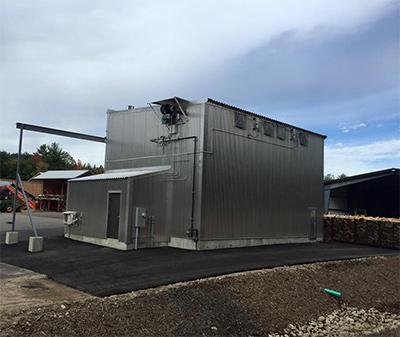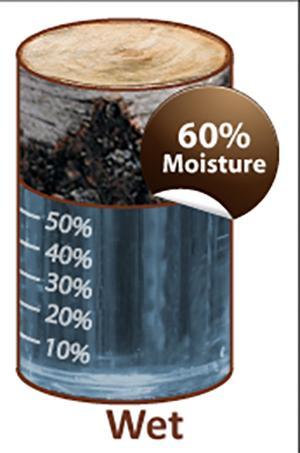Dried Firewood
Why moisture content is so important
The idea behind kiln-dried firewood is to have a wood fuel that burns well and consistently. Water in the wood naturally acts to slow down the fire. The furniture and lumber industry has been using kiln-drying wood to prevent drying and shrinkage over time, causing warping and cracking that causes problems with furniture making or with the building trades trying to work with wood that is not dry. Exposed to the air, the wood dries out. It is just inevitable. So, over time, the industry had to work on a solution.
The same technology used to dry lumber is applied to create dried firewood. It is just more of a niche specialty product that many are unfamiliar with or have not seen. It is just a very large oven that heats the wood and circulates air around the wood to pull the water out of the wood. It is not run at 350 degrees like you would bake a cake, but the hardwood is in metal bins and held at high temperatures to suck the moisture out of the wood as efficiently as possible.
The focus on Moisture
 When the interest is in having a warm fire for its ambiance or taking the edge off a cold winter night, enjoying a great fire is a primal instinct. As anyone who watched the TV show Chicago Fire, when all the people are out of the building, and then they go to put out the fire, water is sprayed on the fire to put out the fire. Otherwise, the steam and smoke generated in the building would be too much to handle. Firemen use the opposite concept of how to build a good fire in a fireplace.
When the interest is in having a warm fire for its ambiance or taking the edge off a cold winter night, enjoying a great fire is a primal instinct. As anyone who watched the TV show Chicago Fire, when all the people are out of the building, and then they go to put out the fire, water is sprayed on the fire to put out the fire. Otherwise, the steam and smoke generated in the building would be too much to handle. Firemen use the opposite concept of how to build a good fire in a fireplace.
To build a good fire, the wood should be stacked for good airflow, be dry, and have consistent heat close to the wood fuel for the wood to maintain itself and keep burning. Firemen work to starve the fire of oxygen, cool the area, and remove fuel from the fire. Huge amounts of steam are created, and the burning area is cooled. "Water puts out fire mainly because it's a really good heat sink," The fire goes out.
The science of water on a wood fire
Adding water to the fire takes energy from the fire. The same as a pot of water takes time to boil by adding energy, the water added to a fire takes away energy from the fire. It takes the heat and causes the water to evaporate, cooling the fire.
The water cools the fire and starts to coat the wood with water. This coating of water deprives the fire of oxygen that is critical for a fire to burn. The water is sprayed in a fine mist to help disperse it over the fuel to coat the area as best as possible. The effort is to soak the fuel, not just heat the water. Less oxygen to the wood means less availability to burn the wood. The calculation for heating water is the mass of water times the heat capacity of water to evaporate it. A BTU is the amount of water to heat one pound of water one degree. So, the more water added to a fire, the more the mass of water puts out the fire.
The same theory applies to water in firewood. It is talked about as moisture content in wood. It naturally fights against the wood burning since the water must first evaporate before it can burn. So, the water is just like a fireman trying to extinguish the fire.
How much water can be in firewood?
 It all depends, but it can be as high as over 120% in some woods that are not really dense. As an example, freshly cut Sugar Maple (Acer Saccharum) is about 60 %. No one disagrees that dried hardwood is great for burning, but all the terms about green, seasoned, and kiln-dried all revolve around getting the water out. A cord of maple green can weigh 4684 lbs. Then, when at 20%, the weight is 3,680 lbs. So, about 1,000 pounds of water have been removed, or to put it in the context of another context of gallons, it would be taking out 143 gallons.
It all depends, but it can be as high as over 120% in some woods that are not really dense. As an example, freshly cut Sugar Maple (Acer Saccharum) is about 60 %. No one disagrees that dried hardwood is great for burning, but all the terms about green, seasoned, and kiln-dried all revolve around getting the water out. A cord of maple green can weigh 4684 lbs. Then, when at 20%, the weight is 3,680 lbs. So, about 1,000 pounds of water have been removed, or to put it in the context of another context of gallons, it would be taking out 143 gallons.
The benefit of Dried Wood
Kiln drying quality native hardwoods provide consistency for the customer. Avoiding the need to dry the wood and a quality wood input creates an easy-to-light, relatively smoke-free fire. High-density wood with minimal moisture provides an easy-to-light fire and a fire with a good duration. An example of this in terms of the user is as follows. A company sold a wood stove, and the customer could not get a decent stack temperature. The stack temperature is a measure of heat the stove can provide. He was getting 250 degrees and felt it was the stove's fault. Visiting the customer, the person who sold the stove took our kiln-dried wood and started burning that, and the stack temperature went to and stayed at 520 degrees for hours controllably. If you enjoy a nice wood fire, buy some of our kiln-dried wood and see if our kiln-dried wood and stacking service is worth it.